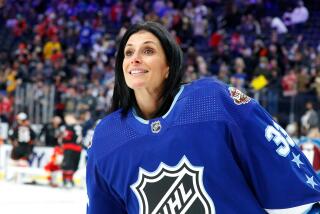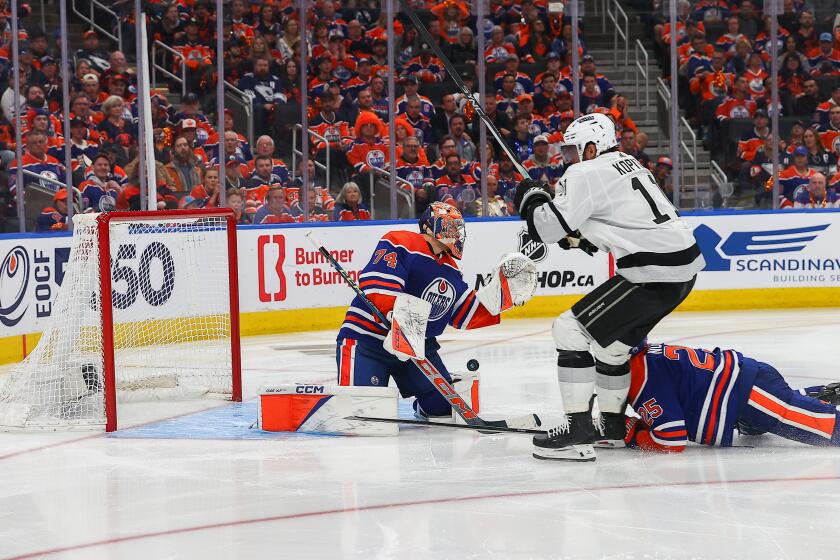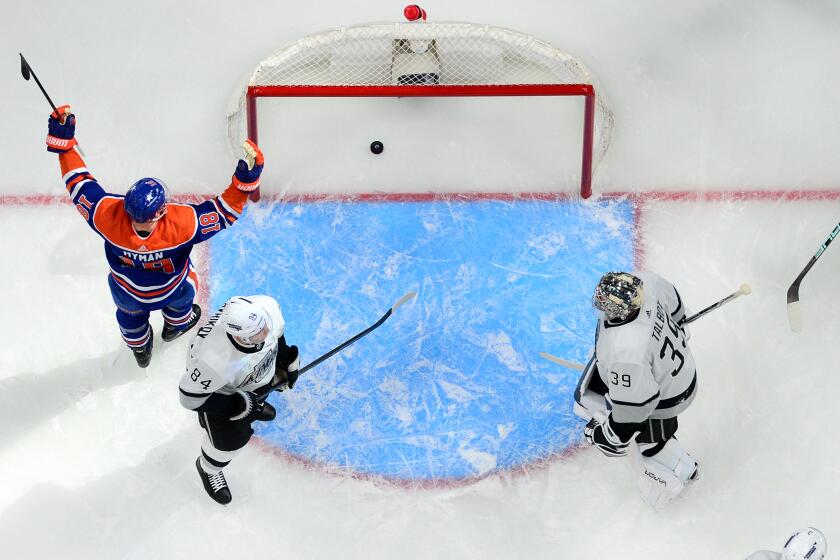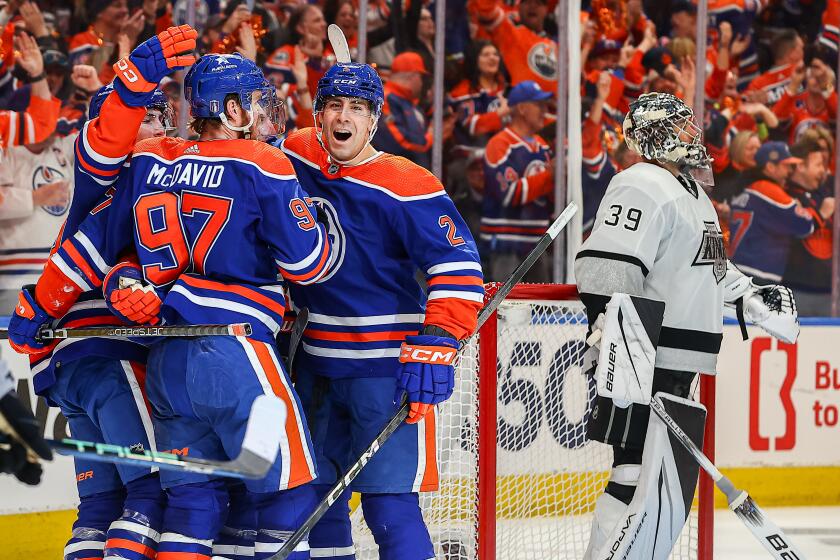NHL Must Push Itself
Political regimes have risen and fallen in less time than it’s taking the NHL and the players’ association to officially resolve their labor woes.
Having agreed on the bedrock of a new deal, they’re refining language and closing potential loopholes, the final step before the NHL begins sifting through the rubble of destruction, disillusionment and, perhaps worse, apathy.
The NHL will return next season with no cable TV contract in the U.S. Its meager over-the-air TV deal with NBC -- seven regular-season games, six playoffs, plus four Stanley Cup finals games -- pays no money up front, establishing a precedent for every future deal it negotiates.
In formulating numbers for its first-ever salary cap and linking salaries to a maximum of 54% of league revenue, negotiators reportedly estimated the league’s revenue will be $1.8 billion, down from a peak of $2.1 billion before the lockout. That’s a generous estimate.
But hey, the NHL will have a new public relations campaign whose working title has a catchy slogan:
It’s a Whole New Game.
That should fix everything right there, because the NHL’s previous campaigns were so successful and led to record TV ratings and profits for owners and ... oh, they didn’t. Never mind.
The NHL cannot market and promote itself as it has before. It needs new vision, a recognition that its old ways didn’t work and that too many people still think of hockey as a foreign game played by toothless Canadian backwoodsmen and couldn’t explain icing or offside for a $1-million prize.
Putting microphones on coaches or players or referees won’t change that. The remedies are more complicated.
Riding the wave of technology-driven ideas, the NHL plans to draw fans with blogs and polls about game-related issues. It must also forge a true marketing partnership with players, because rebuilding the league’s image and financial strength is in players’ interest under a labor agreement built around a salary cap that’s tied to league-wide revenue.
The bigger the revenue, the higher the cap and more that players can earn.
High-definition TV will help hockey’s renaissance because it will bring depth and perspective that eludes conventional TV. It will make it easier to see plays develop, anticipate passes and get a feel for what’s happening, because viewers won’t be restricted to camera shots that slavishly follow the puck.
But it’s not the only answer, because it’s costly and HD sets are making slow inroads into America’s living rooms.
The obvious fix is to the rules that govern the game. Yet, the NHL faces a quandary there. Does it make massive changes in an effort to appeal to a new audience, and risk alienating its remarkably loyal core fans? In its eagerness to reposition itself as new and improved, like a detergent or toothpaste, will the Whole New NHL sell what’s left of its integrity and its soul?
The most pressing problem is the scoring decline. Allowing the flow to deteriorate meant that fewer goals were scored off rushes and took away the speed and creativity that make hockey unique.
It also minimized the league’s ability to promote stars. Fifty-goal scorers and 100-point scorers became endangered species, depriving fans of the emotional involvement of following a player’s quest for a milestone.
The dozen or so rules that have been proposed to promote offense are like the collective bargaining agreement: legislation designed to save clubs from their own excesses and short-sightedness. And they need saving.
Two changes are inevitable: Goaltenders’ leg pads will be narrowed by a few inches and their jerseys will be less voluminous, eliminating the “Michelin Man” syndrome, and shootouts will be adopted to settle ties.
Limiting goalies’ equipment isn’t a bad idea. Some resembled linebackers with their oversized shoulder pads. However, goaltending has become a science in the last 15 or 20 years and has attracted elite athletes who might have otherwise been forwards or defensemen. Thanks to Patrick Roy, legions of French Canadian kids dreamed of being great goalies instead of the next Guy Lafleur or Rocket Richard. No rule can legislate against that.
Under the likely shootout scenario, games that are tied after 60 minutes would be followed by three minutes of four-on-four sudden-death overtime. If they remain tied, they’d play three-on-three for two minutes. If they’re still even, they’ll go to a shootout, as at the Olympics.
There’s drama in shootouts, especially if the loser gets no points instead of one point for an overtime loss, as has been the case. There’s no guarantee the excitement will last a full season. Settling an Olympic medal through a shootout is electrifying. Settling a Thursday night game between Carolina and Florida with a shootout is somewhat less spine-tingling.
What happens, too, if scoring increases only slightly? Does the NHL then make goalies play with baseball bats and adopt soccer-sized nets?
Bringing the NHL back to life will take creativity and vision, traits the league lacked during the years it was so busy planning the lockout.
If the NHL is going to matter anymore a Whole New Game demands a whole new way of thinking.
More to Read
Go beyond the scoreboard
Get the latest on L.A.'s teams in the daily Sports Report newsletter.
You may occasionally receive promotional content from the Los Angeles Times.






